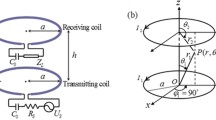Abstract
A theoretical analysis is developed to determine the behaviour of the unipolar pacemaker catheter as a receiving aerial. The theory is used to predict the effect of parameters such as the frequency and the length of the catheter on the coupling of electromagnetic interference to the pacemaker. The results are presented in terms of an equivalent circuit which is useful for developing simple experimental tests to evaluate the susceptibility of pacemakers to electro-magnetic interference. The theoretical results are shown to be in good agreement with measurements made on an actual catheter.
Similar content being viewed by others
References
Bonney, C. H., Rustan, P. L., Jr. andFord, G. E. (1973) Evaluation of effects of the microwave oven (915 and 2450 MHz) and radar (2810 and 3050 MHz) electromagnetic radiation on noncompetitive cardiac pacemakers.IEEE Transactions Biomed. Eng.,BME-20, 357–364.
Bussey, H. E. (1967). Measurement of r.f. properties of materials: a survey.Proceedings IEEE,55, 1946–1053.
Denny, H. W., Jenkins, B. M. andToler, J. C. (1977) Behavior of cardiac pacemakers in pulsed EM fields. Proceedings of IEEE International Symposium on Electromagnetic Compatibility, Seattle, WA, 272–277.
Furman S. andEscher, D. J. W. (1970)Principles and Techniques of Cardiac Pacing, Harper and Row, New York.
Johnson, C. C. andGuy, A. W. (1972) Nonionizing electromagnetic wave effects in biological materials and systems.Proceedings IEEE,60, 692–718.
Kahn, A. andSchlentz, R. J. (1973) Design and construction methods for protecting implanted cardiac pacemakers from electromagnetic interference, InThalen, H. J. (Ed.)Cardiac pacing. Von Gorum and Co., Assen, The Netherlands.
King, R. W. P. andSmith, G. S. (1981)Antennas in matter: Fundamentals theory, and applications. MIT Press, Cambridge, Ma (in press).
King, R. W. P., Lee, K-M, S. R. andSmith, G. S. (1974) Insulated linear antenna: theory and experiment.J. Appl. Phys.,45, 1688–1697.
King, R. W. P., Mishra, S. R., Lee, K-M andSmith, G. S. (1975) The insulated monopole: admittance and junction effects.IEEE Trans. Antennas Propagat.,AP-23, 172–177.
Lichter, I., Borrie, J. andMiller, W. M. (1975) Radiofrequency hazards with cardiac pacemakers.Brit. Med. J.,12, 1513–1518.
Mitchell, J. C. andHurt, W. D. (1976) The biological significance of radiofrequency radiation emission on cardiac pacemaker performance, InBiological effects of electromagnetic radiation, Vol. II, HEW Publication (FDA) 77-8011, 212–228.
Moore, R. K. (1967) Radio communication in the sea.IEEE Spectrum,4, 42–51.
Pacemaker Standard (1975) The Association for the Advancement of Medical Instrumentation (AAMI), Report Prepared for the Food and Drug Administration, FDA Contract No. 22-74-5083.
Roy, O. Z. (1975) The current status of cardiac pacing.CRC Critical Reviews in Bioengineering,2, 259–327.
Schlentz, R. J. (1975) Electromagnetic compatibility of implanted cardiac pacemakers. Proceedings of Symposium on Electromagnetic Compatibility, Montreux, Switerzland, 428–431.
Smith, G. S. (1972) The proximity effect in systems of parallel conductors,J. Appl. Phys.,43, 2196–2203.
Van Wijk Van Briervingh, R. P., De Bakker, J. M. T., Hoekstra, A. andHemelaar, A. (1974) Measurement techniques for assessing the influence of electromagnetic fields on implanted pacemakers.Med. Biol. Eng.,12, 42–48.
Yatteau, R. F. (1970) Radar induced failure of a demand pacemaker.New Eng. J. Med.,283, 1447–1448.
Author information
Authors and Affiliations
Rights and permissions
About this article
Cite this article
Smith, G.S., Toler, J.C. Analysis of the coupling of electromagnetic interference to unipolar cardiac pacemakers. Med. Biol. Eng. Comput. 19, 97–109 (1981). https://doi.org/10.1007/BF02443854
Received:
Issue Date:
DOI: https://doi.org/10.1007/BF02443854




